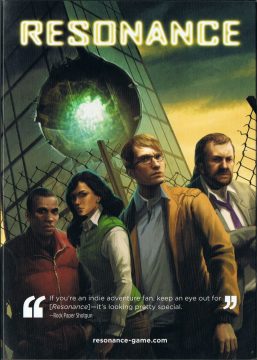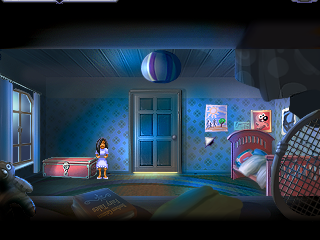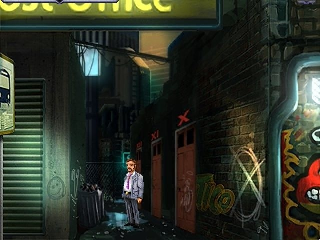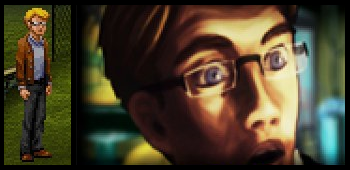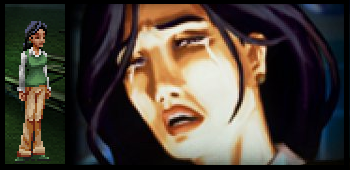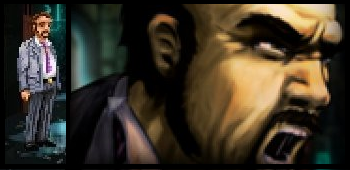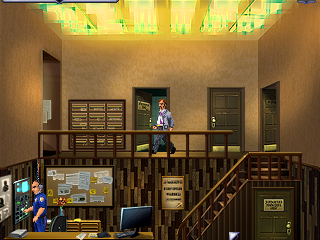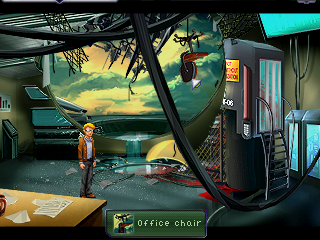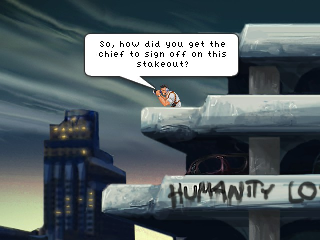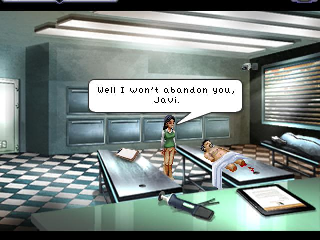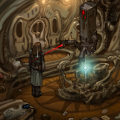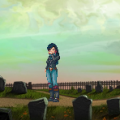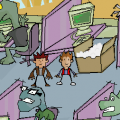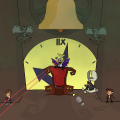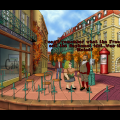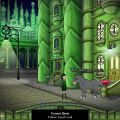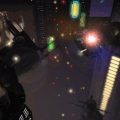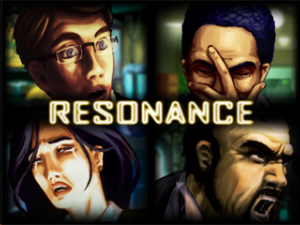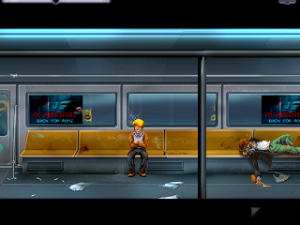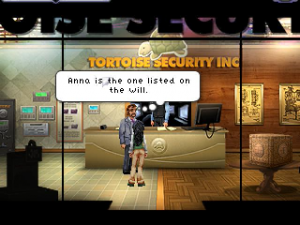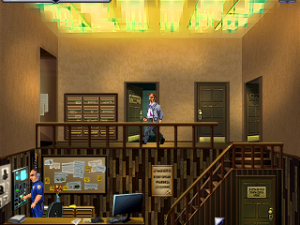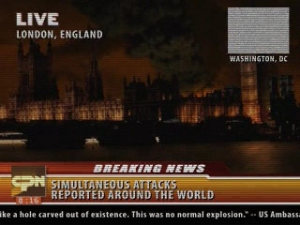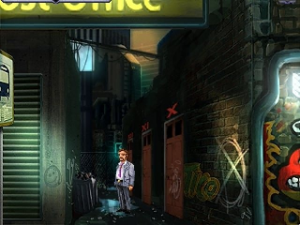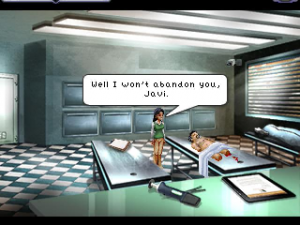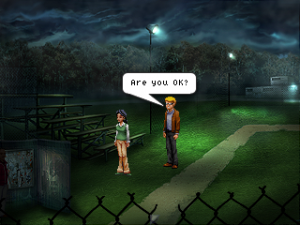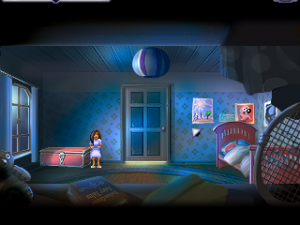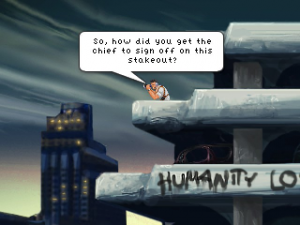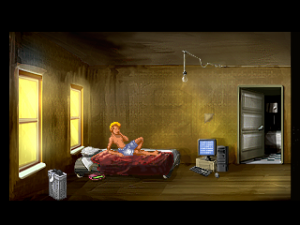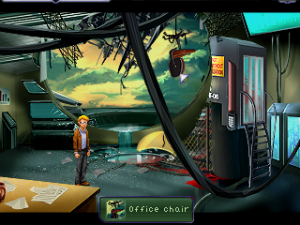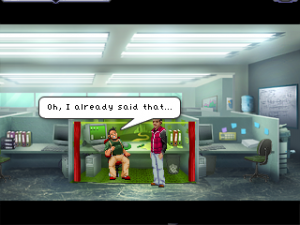“Resonance: When one object vibrating at the same natural frequency of a second object forces that second object into vibrational motion.”
In our current generation of videogames, the point-and-click adventure genre no longer stands as one of the main pillars of the market. Interest plummeted post-Grim Fandango, with the turn of the millennium. They just didn’t have the same spark in a market that demanded more high-intensity games. But only a few years later the genre regained its momentum, this time around in the indie gaming scene with the creation of Adventure Game Studios and with groups like Telltale Games to promote it. And now, we have a healthy, devoted, if small, community of fans and developers who help innovate and expand the genre.
Many contemporary developers create adventure games as homages to the sorts of Sierra and LucasArts games they grew up playing. Sort of like a chance to revisit the experiences that now bring us such warm feelings of nostalgia. With the amount of tools available to us, though, our homages begin to surpass the originals. Such is what I’ve found with a wonderful little game called Resonance. While not directly influenced by any game in particular, xii games’ Resonance is a compelling example of just how great a modern point-and-click adventure can be.
The game begins in medias res, with a news report on multiple terrorist attacks that have just taken place in various key locations around the world. From the grainy images on screen, the player sees buildings with huge smooth spheres of matter blown out of them (as seen in the cover art). Fires and destruction are rampant, and nobody has a clue what’s going on. The reporter does note however that the attacks bear an uncanny resemblance to an accident that occurred in Juno Laboratories in Aventine City a few days prior…
We rewind time 60 hours earlier, and find Ed, the first of our four main characters asleep in his shabby apartment in Aventine City. From here the game proper gets going. He gets a phone call from his boss, particle physicist Doctor Morales, who tells Ed that he is shutting down his project, Resonance, due to ethical reservations regarding what the technology could be used for. Ed, confident in the technology’s benefits, is defiant, but before he even has time to argue, something happens to Morales, and the technology is compromised: Someone wants Resonance for malicious ends. All Ed knows is that the classified details of the project are left in a hidden vault somewhere, and that he’s not the only one searching for them.
From there, the game follows three other individuals and reveals how they too find themselves driven toward finding Resonance. The four band together to find it before it falls into the wrong hands.
Characters
Tolstoy “Ed” Eddings
A mathematician, “better with numbers than with people.” His familiarity with the technology makes him an essential par of the team, as well as a convenient source of exposition. He is wholly confident in Resonance technology and driven to protect it despite his awkward personality. Voiced by Edward Bauer.
Anna Castellanos
An ER doctor with unresolved childhood trauma. She is Doctor Morales’ niece, and far more connected to the secrets that lay behind the vault than she realizes. The flashbacks to her past are some of the scariest parts of the game. Voiced by Sarah Elmaleh.
Detective Winston Bennet
A senior detective with the Aventine City Police Department, currently following a lead beyond police regulations. Follows his gut and not his head. Clearly a “from the block” kind of guy. Voiced by Logan Cunningham, the acclaimed narrator of Bastion.
Raymond “Ray” Abbot
An investigative journalist for a popular online news source, he talks with a Mid-Atlantic accent and is talented at maneuvering through conversations to get information out of most people. A bit too sure of himself, which causes tension with Detective Bennet. Arguably the most endearing character. Voiced by Daryl Lathon.
Resonance is foremost the labor of Vince Twelve, xii Games’ frontman. He previously created such interesting titles as Anna and What Linus Bruckman Sees When His Eyes are Closed. He began to create Resonance while teaching English in Japan, a job which involved a lot of desk warming and thus a lot of free time. But soon he started to raise a family. He eventually moved back to the US and got a full-time job that kept him more occupied, and i>Resonance was continually pulled into the back burner.

As a result, Resonance was in production for about six years.
The game received a boost in development speed when xii Games teamed up with Wadjet Eye Games, creators of the lauded Blackwell series and the rabbinical adventure The Shivah. The husband and wife duo provided much-needed feedback in smoothing out the game and turning it into a commercially polished product. Janet Gilbert worked on the game’s programming while Dave Gilbert produced it and served as voice director.
Shane Stevens (The Shivah, Blackwell Convergence, and Mind’s Eye) created the game’s character designs and animations. They are low resolution, but each and every pixel was selected with care. The characters are vibrant and colorful, but nonetheless realistic, and they move fluidly through cutscenes and actions. There really is an impressive amount of animation in Resonance. This is shown right off the bat in the first scene, when Ed gets up out of bed in a daze and rustles through his hamper to find his cellphone. Each little action is intricately animated, no skirting around it.
Nauris Krause designed the backgrounds, which are gorgeous, eclectic, and brimming with little details. Despite running at only 320×240 resolution, the world of Resonance is alive with color and action. No screen is ever static, there is always something in motion, like smoke rising or a receptionist typing. The explosion site in Juno Laboratories is particularly striking, with its fires and leaking pipes and torn electric cables. The game prides itself on its low-res, high-quality approach, and deservedly so.
Nikolas Sideris (A Tale of Two Kingdoms) designed the music and sound. These facets, too, are worthy of much praise. Each track matches its location perfectly, from irritatingly catchy lobby music to an epic sci-fi fanfare. Anna’s nightmares are particularly terrifying, as the sound direction, with its ever-louder pounding at the door and demonic shrieks, really drive home the feeling of terror and tension.
Resonance‘s gameplay is essentially standard point-and-click adventure fare, but more engaging due to its smooth interface and a couple unique features. For one, there is the character swapping. Switching between four different characters is, while nothing new in the genre, effectively pulled off. It works fluidly and without any apparent bugs, which is a huge threat with this kind of feature. The characters in the game world even react differently to different protagonist, making it much more realistic and fleshed-out.
None of the puzzles are especially difficult, but they do make good use out of character swapping. One particularly involved puzzle requires you to flip switches to activate giant magnets in order to move large pieces of debris out of the way. The problem is that while two characters are able to walk under the magnets when they’re in power, the other two can’t. Otherwise, most puzzles simply involve conversations and using items in the right places, but they fit the story and are never overly obtuse.
The most interesting and innovative aspect of the gameplay is perhaps the memory system, which is so new in the genre but makes so much sense you wonder why it hasn’t been done before. Basically, each character has a set of short-term and long-term memories to choose from. Long-term memories are flashbacks to pivotal plot points during the game, or else events from the characters’ pasts, that help to flesh out out the story and assist in solving puzzles. Short-term memories are more like items to bring up in dialogue. You can add literally any object in the game to your short-term memory and use it in conversation. Instead of just using the dialogue options, then, you have to use your head and think of what conversation piece the character will respond to. One character, for instance, is popping pills, and in order to bring that up in conversation you have to add the pill bottle to your short-term memory and use it on the character. It can be rather fun. Bringing up seemingly insignificant short-term memories and yield amusing results.
There is also a point system reminiscent of old Sierra games like King’s Quest. It’s little more than an offer of a sense of completion, otherwise there’s no tangible reward.
The main draw of Resonance is in its plot. Adventure games have a tendency to lose their tension or have trouble building it up. Too gradual or too poorly paced, something gets in the way. Even the best of them – Broken Sword and Gabriel Knight come to mind – seem to have their main characters walk around on a wild goose chase for too long without anything apparently at stake, nothing for the player to anticipate or dread. But in Resonance there is a clear and immediate conflict, and even in its most relaxed moments you know there is a lot of sinister conspiracy at work. It is very well told. The characters are vibrant, the dialogue entertaining, and a lot of visceral drama, which is difficult to pull off in this genre. It is a dark game for sure, but it’s also exceedingly charming, and xii Games does a wonderful job combining these two seemingly at-odds characteristics.
Perhaps one point of criticism stems from a twist somewhat near the end of the game. In the most general sense, something changes more drastically than the story indicates it ever would. It is a jarring twist in good and bad ways, and players will probably be divided on its logic and efficacy.
In sum, while not without flaws, Resonance is arguably one of the best adventure games out there right now. It honors its predecessors, but takes advantage of improvements in game-making technology to make the experience smoother and more enjoyable. Some aspects of the game are reasonably subject to criticism, but the pros far outweigh the cons. And at a length of around 7 to 10 hours, it neither exceeds nor under-stays its welcome. With excellent voice-acting, an engaging story, memorable characters, an innovative memory system, and a lively setting, Resonance comes highly recommended.
Links:
GOG Page
xii Games Page
Wadjet Eye Games Page
Destructoid Review
Interview with Vince Twelve

